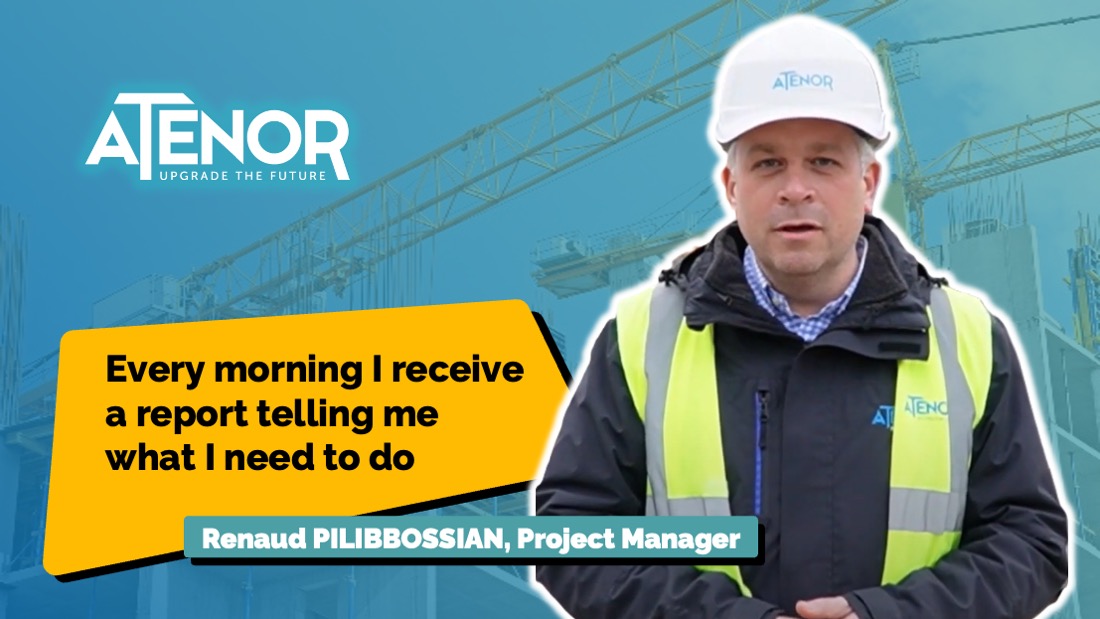Introduction
BIM World 2023: The Construction Hub to Address the Multiplicity of Digital Tools and Enhance the BIM Model in One Click

Cooperlink is a Belgian startup founded in 2017 and currently has over 1000 companies using our collaborative platform on a daily basis. The company has already proven itself by successfully supporting prestigious projects, particularly in Brussels and Antwerp. Today, we are embarking on conquering the French market.
In this article, we will explore the highlights of Axel Palmers' presentation, focusing on two key subjects. Firstly, we will delve into the detailed concept of the "construction hub" proposed by Cooperlink. Then, we will dive into the exciting world of enhancing BIM models, exploring a research project currently under development.
Cooperlink's innovative technology has already won over numerous market leaders who regularly adopt it in their professional daily routines. Our proven solution offers a powerful approach to managing the complex challenges related to construction and team coordination.
Discover below how Cooperlink transforms construction sites by facilitating collaboration among different stakeholders in the industry, and soon allows you to fully harness the potential of BIM.
Happy reading!
Complex Construction Site Management Support: The Core Expertise of Cooperlink
Each stakeholder in a construction project, whether it be a subcontractor, general contractor, project manager, or client, uses separate tools.
This fragmentation results in a multitude of platforms and tools that do not effectively communicate with each other, causing information to be lost with every exchange between project participants.
This represents a significant digital disconnect faced by various stakeholders in a construction project.

When collaboration is required among all these stakeholders, they are faced with the tedious task of repeatedly re-entering information into their internal tools.
Data re-entry: the reality for many companies in the construction industry
A study conducted by Cooperlink has revealed that the same information is re-entered up to six times, leading to a significant loss of time and money. Moreover, each stakeholder often tries to impose their own platform, creating further confusion and challenging the idea of a single source of data.
This multiplicity of platforms creates a real challenge, often likened to a digital Tower of Babel. Companies find themselves with multiple specialized internal platforms, such as a dedicated construction application and another for document management. This complex situation generates operational issues and significant risks for the various stakeholders. Data is repeatedly re-entered, resulting in inefficiency and an increased likelihood of errors.
Each stakeholder has their reasons for using their own platform. For example, the client, as the future operator of the building, needs access to the complete history of information. This is why they often end up imposing their own platform, not because it is superior, but simply because they require access to the entire project lifecycle.
These behaviors trigger a series of chain reactions and operational challenges, creating significant risks for the involved companies.
Significant Costs and Risks
The technical sheet as a perfect example of multiple re-encoding that could be avoided
Imagine a situation where a technical sheet is received via email. This sheet needs to be transformed into a transmitted schedule, then copied onto a Sharepoint. Next, it is merged with other documents in PDF format, re-entered, and uploaded onto a specific platform. From there, it is re-entered again to create a register.
This tedious process represents the on-the-ground reality for many project managers and site supervisors.
Managing documents and information on construction sites often involves a series of repetitive and time-consuming steps.

Cloud applications: a false good idea
The use of cloud-based collaborative platforms poses another major challenge. Internal company data is not always up to date compared to the data present on the collaborative platform. Therefore, if the project manager does not retrieve the updated documents from the collaborative platform, this information does not reach the internal platforms of the company. This means that the site supervisor, on their own site and dedicated platform, does not have access to the correct information.
The challenges of the As-built record (or Dossier des Ouvrages exécutés) and its completeness
The observation is that companies are losing control over their data. It is not uncommon to find that the As-built record, the Dossier des Ouvrages Exécutés (DOE), is incomplete. Many essential pieces of information are missing due to time constraints and the constant transition between different projects. The internal governance of the company is also affected, compromising its ability to meet quality standards and internal policies, such as ISO 9001.
The introduction of multiple platforms leads to additional costs, particularly in terms of training for users. Furthermore, the hastily prepared DOE often fails to meet the expected quality requirements.
The specific problems and needs of stakeholders and the search for interoperability
Each stakeholder involved in construction projects faces their own problems and has specific needs.
Subcontractors, for example, require easy access to information and do not want to connect to multiple platforms.
General contractors, on the other hand, need to manage a large volume of data and comply with standards such as ISO 9000. Additionally, they have obligations regarding the ten-year warranty, making internal information storage crucial.
Clients focus on the future operation of the buildings and want to find information in their own tools.
For project management, coordination and quick decision-making are essential while maintaining traceability and preserving opinions.
As mentioned earlier, the digital disconnect between different stakeholders is also a major problem. For example, regulatory bodies are legally required to keep their assessments within their own platforms, preventing them from using external platforms and leading to information duplication.
To address these challenges, there are different approaches, including interoperability. One approach is to have an all-in-one platform, similar to a "construction SAP." While this approach offers advantages in terms of simplicity and smoothness, it can lead to excessive vendor dependency, a reduction in tool specialization, and friction with partners who do not share the same platform.
On the other hand, working with all systems using custom integrations is an interesting option that meets specific needs and allows for the preservation of the existing ecosystem. However, this can result in high costs, particularly for the maintenance and evolution of integrations.
Cooperlink has chosen to position itself between these two approaches. The objective is to offer an integrated all-in-one platform that brings together and consolidates all the necessary applications, thereby enabling data centralization.
The construction hub: an answer to market needs and the multiplicity of tools
The concept of the construction hub is based on creating a coordination space where internal teams and partners can work on a common dataset.

A common dataset within each individual's tools
At Cooperlink, our main objective is to have a common dataset while using specific tools for each stakeholder.
We work with a single tool, similar to a main platform that provides a single source of data. However, this single source of data brings together each stakeholder's internal tools. We use connectors, similar to Google Translate, to facilitate translations between all the applications.
We aim to avoid the infamous customer lock-in and enable you to maintain control over your data by storing it on your own premises. If a vendor who imposes dependence on you increases their costs, you do not want to be caught off guard. Having control over your data is essential.
The construction hub as a response to the needs of different construction stakeholders
We have observed that there is a multitude of tools used by different stakeholders in a construction project, which leads to the search for a unified digital workspace when it comes to working together.
Regardless of the software used on the construction site or other internal platforms of the company, everyone needs access to the same up-to-date data and information. There is a growing disillusionment with public cloud solutions. Costs are increasing, especially those related to energy, not to mention the customer lock-in issue we discussed earlier.
That is why, with Cooperlink, we have created the construction hub in the form of a network. Each company that is part of Cooperlink has its own database. Therefore, when collaboration between different entities ends, each retains the complete history of their data and has access to all relevant information.
Unlike cloud collaboration platforms that may restrict access at the end of the project, we guarantee continuous and full access to the data. We also commit to being open data and working with open-source databases, ensuring complete data preservation.
The core tools of the company, such as Document Management Systems (DMS), CRM, PR, etc., remain at the heart of our platform. This truly consolidates these core tools. It is not uncommon, with some cloud platforms, to find a SharePoint containing certain data, a collaborative platform containing other data, and so on. This data fragmentation is a major problem as it can result in the loss of a portion of the project's data when a project is concluded.
By working with a construction hub, we consolidate the company's internal tools. While API integration may seem technical and complex, we strive to make interconnectivity as simple as possible. To that end, we have developed a ready-to-use platform. Of course, not everything is possible, but we have established connections with a range of leading market platforms such as Autodesk, Oracle, SharePoint, Aconnex, BIM 360, and many more.
Simplifying project management and optimizing collaboration
Cooperlink, a solution suited to projects of various scales
At Cooperlink, we take pride in actively participating in projects of all sizes, from small residential constructions to large-scale endeavors. We work on multi-apartment residential buildings as well as hospital projects. We are often involved in extensive projects involving consortiums of companies.
One of our ongoing significant projects is the Westerwelle Link in Antwerp, valued at 500 million euros. We collaborate with five stakeholders to ensure optimal connectivity and coordination. Another example is the upcoming Liège Expo project, where we successfully connected the architect, general contractor, engineering firm, and road specialists.
We are witnessing an increasing demand for interconnected projects as industry professionals recognize the importance of accessing data in a seamless and transparent manner.
For each project we support, our goal is to simplify processes, automate tasks, and reduce costs. By centralizing data, we ensure its reliability and accessibility at the right time and place.
Cooperlink and its numerous features
As a platform, we offer a comprehensive range of features to address document management, correspondence, price requests, task coordination, and deliverable creation needs. We automate processes, facilitate the generation of customized reports, and connect to external systems through our connectors. Additionally, we have an ongoing research project focused on BIM, which will enable us to introduce new features by the end of the year.

At Cooperlink, we understand that each project is unique and requires a customized approach. We take pride in our ability to consolidate your company's core tools, eliminating data silos that can hinder collaboration. Our goal is to simplify API integration and make interconnectivity as seamless as possible, allowing you to benefit from a smooth and efficient experience.
On the road to the BIM Construction Hub
The construction industry is evolving with Building Information Modeling (BIM), and so is Cooperlink
In our pursuit of digital continuity, we sought to expand our solutions into the realm of Building Information Modeling (BIM). To achieve this, we initiated a research project based on the observation of data silos between design and execution, as well as the low adoption of BIM in the execution phase.
Currently, only 5 to 10% of projects are using BIM, which creates issues with data quality and high costs for remodeling and reproducing information.
Therefore, we aimed to address this problem by creating an automated link between on-site data and the BIM model.
In collaboration with the Research laboratory LUCID at the University of Liège and BuildWise, the Belgian research center for construction, we simplified this connection by working on custom classifications, data dictionaries, and ontological concepts. Thus, we expanded Cooperlink to create a true "BIM Construction Hub."

Automatically enriching a BIM model, a dream soon to be realized in Cooperlink
The goal is to automatically enrich the BIM model during the execution phase, without requiring the expertise of modelers or BIM specialists. With this extension, data communication is facilitated, enabling quick retrieval of technical sheets corresponding to specific objects in the model. Additionally, the management of equipment and site objects' lifecycle has been integrated to create an exploitable BIM deliverable for stakeholders in the operational phase.
We have adopted a concept of separation between the geometric part and the data part, with dynamic linking criteria based on standardized and customized classifications. As a result, when the model is updated, the information automatically refreshes. Furthermore, we have made the system fully adaptable by allowing for changes in modeling conventions.
We are also working on data dictionaries to optimize data organization, using parameters such as IFC.
While our system is not yet market-ready, it will be available by the end of the year. It is important to note that the concept of assets (or equipment) is initially oriented towards BIM but can be dissociated from a BIM model and used independently. The ultimate goal is to provide a foundation for an exploitable deliverable in the final phase of the building for the benefit of the client.
If you would like to stay informed about the BIM Construction Hub, follow us on LinkedIn: Cooperlink LinkedIn Page
To watch the video of Axel Palmaers, CEO of Cooperlink, speaking at BIM World 2023, visit: Axel Palmaers' BIM World 2023 Talk
What is your project?
Talk to an expert
Tell us more about your project and needs. Our experts will answer your questions within 24 hours.

Laure Bouvier
Project Manager











